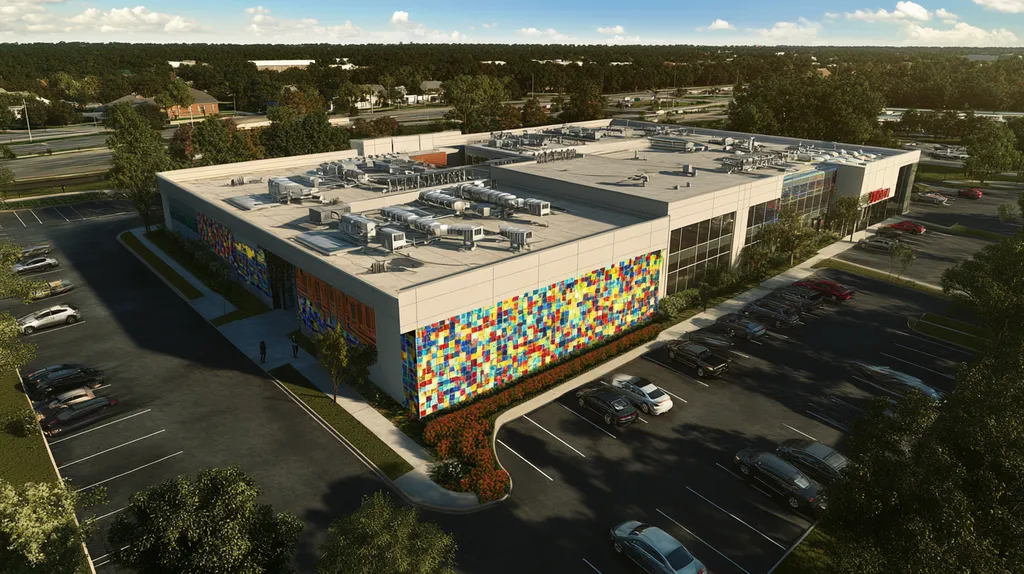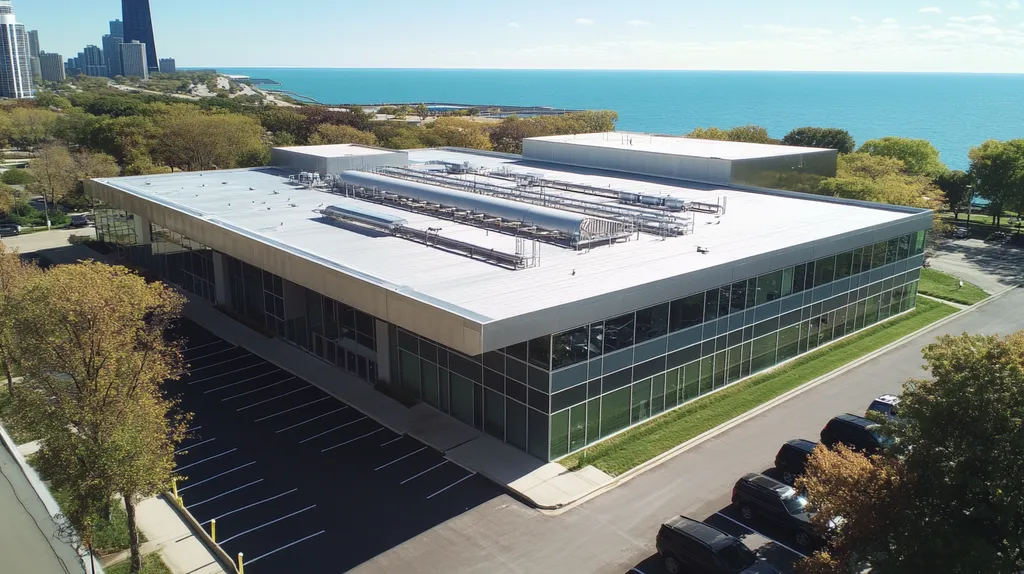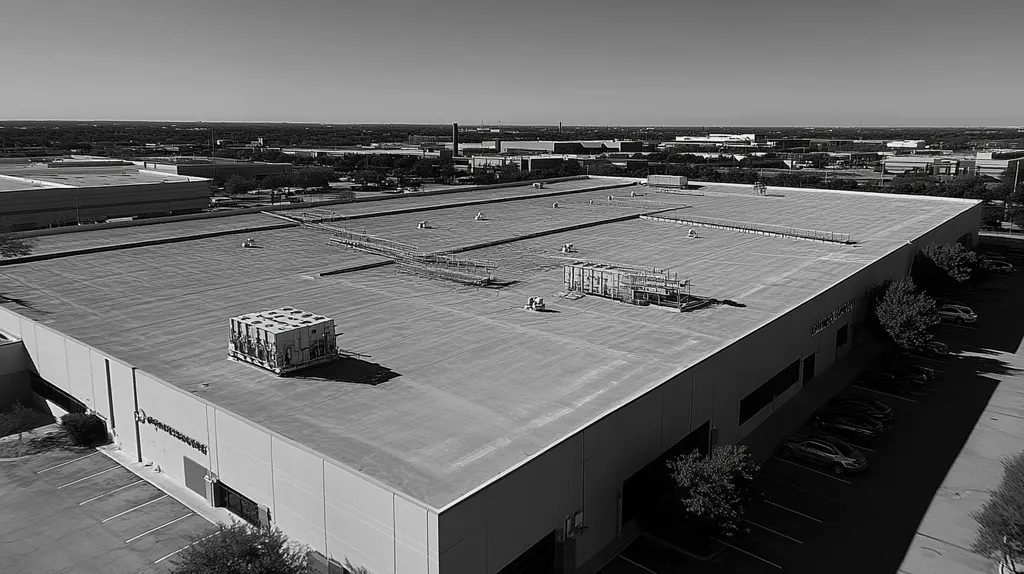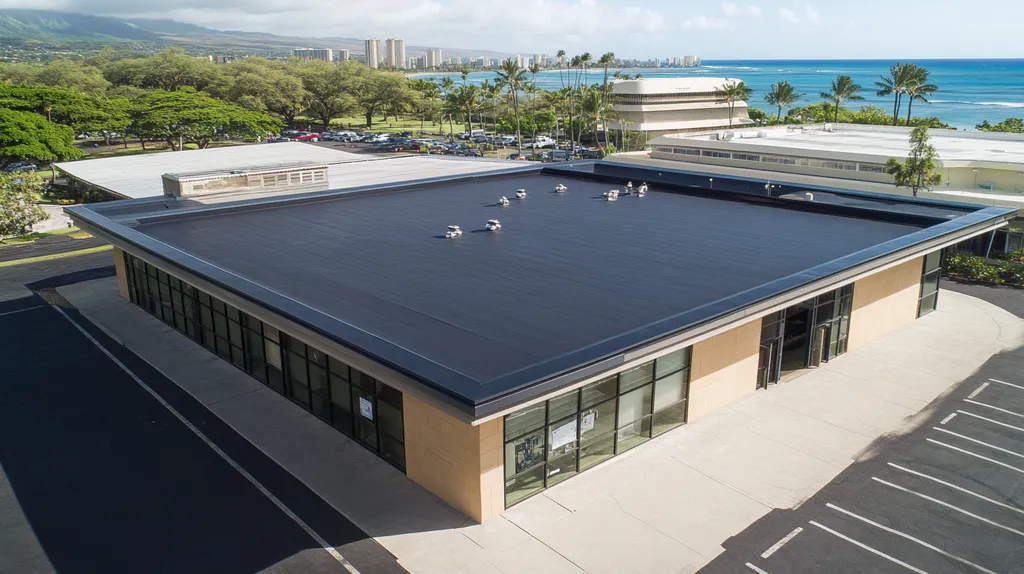Commercial property owners face mounting pressure to extend roof lifespans while managing strict application requirements. Industry data shows that 40% of roof coating projects fail prematurely due to improper installation or incompatible materials, resulting in millions in repair costs annually.
From performance factors and financial considerations to compliance requirements and risk management, navigating coating restrictions demands careful planning and expertise.
This comprehensive guide provides property professionals with actionable solutions to evaluate coating options, ensure proper installation, and maintain long-term roof protection while avoiding common compliance pitfalls.
SECTION 1: PERFORMANCE FACTORS
When it comes to commercial roofing, the implications of applying roof coatings are significant. A hasty decision can lead to financial strains from unexpected roofing failures and higher energy costs. By conducting a comprehensive evaluation of the roof and selecting the right coating, property owners can not only extend their roof’s lifespan but also improve energy efficiency. Grasping these performance factors is essential for making choices that safeguard assets and elevate the value of the building.
Roof Condition Assessment
A detailed assessment of the roof’s condition is vital before any coatings are applied. This inspection can uncover critical issues such as structural weaknesses, moisture intrusion, and material deterioration. By proactively addressing these problems, the roof becomes a more viable candidate for the application of coatings.
For example, roofs exhibiting extensive blistering or curling may struggle to accommodate new coatings properly. Ignoring these underlying issues can result in coating failure, which translates to expensive repairs and unnecessary waste.
Additionally, the age of the existing roofing material must be taken into account. Older roofs may demand more comprehensive repairs or possible replacement, which could render coatings less effective. Therefore, conducting a meticulous evaluation helps clarify the most suitable approach for enhancing roofing longevity.
Key Action Items
Coating Compatibility and Durability
Selecting the appropriate coating involves understanding its compatibility with existing roofing materials. Using the wrong coating can lead to adhesion failures, undermining the protective abilities of the coating. For instance, applying a silicone coating over an incompatible asphalt roof may result in peeling and delamination.
Durability is equally important. Some coatings provide excellent resistance to UV rays, chemical exposure, and foot traffic. Property owners should choose coatings that align with their specific environmental conditions and typical roof usage.
Manufacturer guidelines offer valuable insights regarding compatibility and anticipated durability. Therefore, it’s crucial for property professionals to familiarize themselves with these recommendations to prevent product failures and guarantee lasting advantages.
Key Action Items
Energy Efficiency and Reflectivity
Energy efficiency is a critical consideration in commercial roofing. Reflective roof coatings can substantially lower cooling costs by reflecting sunlight away from the structure, leading to both energy savings and prolonged roof lifespan.
Research shows that reflective coatings can reduce surface temperatures by as much as 40 degrees Fahrenheit. This not only decreases energy expenses but also aids in extending the life of roofing materials.
Furthermore, sustainability initiatives and building codes are increasingly prioritizing energy efficiency. Meeting these requirements can improve marketability and appeal. Property managers should assess how coatings can enhance energy performance and compliance with relevant regulations.
Key Action Items
SECTION 2: FINANCIAL CONSIDERATIONS
The financial implications of roof coating decisions can substantially affect a property’s profitability. A well-maintained roof not only enhances property value but also minimizes energy costs. Property owners must carefully evaluate tax deductions, perform cost-benefit analyses, and plan for long-term maintenance expenses to make informed decisions. Recognizing these financial factors is essential for effective property management in today’s competitive landscape.
Tax Deductions and Credits
Property owners should be aware of various tax deductions and credits available for roof coatings. The Internal Revenue Service (IRS) permits deductions on energy-efficient improvements, including reflective roof coatings. By leveraging these financial incentives, property managers can significantly offset installation costs.
For instance, a commercial property owner who invests in a reflective coating may lower their taxable income, leading to considerable savings, particularly for larger facilities. Staying informed about relevant tax codes and local incentives can yield substantial financial benefits.
Some states also offer rebates for energy-efficient upgrades. Consulting a tax professional knowledgeable about local regulations can help property owners fully maximize these financial opportunities. In this context, understanding the financial landscape is vital for making strategic economic decisions.
Key Action Items
Cost-Benefit Analysis of Coatings
Conducting a cost-benefit analysis is essential when selecting roof coatings. Property owners need to evaluate initial costs against long-term savings, including reduced energy bills and prolonged roof life. For instance, while premium coatings might involve higher upfront costs, their reflective properties can lead to significant energy efficiency over time.
A thorough analysis should also consider potential repair costs and disruptions to business activities. Quality coatings can outweigh their costs, especially in commercial environments where downtime directly impacts revenue. Therefore, property managers should invest the necessary time to assess both short-term and long-term financial effects.
Additionally, the environmental benefits of reflective coatings can enhance a property’s marketability. Buildings marketed as environmentally friendly often attract tenants willing to pay higher rents, making energy-efficient choices economically advantageous. A meticulous cost-benefit analysis empowers property managers to make cost-effective and operationally sound decisions.
Key Action Items
Budgeting for Maintenance and Replacement
Effective budgeting for roof maintenance and potential replacements is crucial for financial stability. Although coatings can prolong the lifespan of existing roofs, they demand regular inspections and upkeep for optimal performance. Property managers should set aside funds for routine maintenance to prevent significant repair costs.
When a roof approaches the end of its lifecycle, replacement expenses can escalate quickly. Advanced planning helps property owners mitigate unexpected financial burdens. For example, properties with a proactive maintenance budget can swiftly address issues before they escalate.
Furthermore, understanding the lifecycle of roofing materials is vital for sound budgeting practices. Investing in high-quality coatings can lessen the frequency of replacements, offering long-term savings. This insight is invaluable during budgeting discussions among stakeholders.
Key Action Items
SECTION 3: COMPLIANCE REQUIREMENTS
Understanding compliance requirements is vital for property owners and facility managers planning to apply roof coatings. Overlooking regulatory standards can lead to hefty fines, reduced roof durability, and serious safety risks. Alarmingly, about 30% of roof coating failures are attributed to non-compliance with local codes. This section breaks down the key compliance elements to consider in your roofing project.
Regulatory Standards and Codes
Compliance starts with knowing the regulatory standards and building codes that apply to your area. These codes vary significantly by location and dictate acceptable materials, application methods, and safety protocols. For example, some areas require roof coatings to adhere to Environmental Protection Agency (EPA) standards concerning volatile organic compounds (VOCs).
Failure to follow these regulations can expose property owners to substantial fines and environmental liabilities. Regularly reviewing local building codes and consulting with local authorities is essential for staying compliant.
Additionally, understanding standards related to fire resistance and energy efficiency is crucial. Coatings should be certified to meet these criteria, as this can influence insurance premiums and overall safety. By staying informed about shifting regulations, property owners can safeguard their investments and maintain safe environments for occupants.
Key Action Items
Qualifications for Commercial Use
It’s crucial to ensure that the roof coatings chosen are appropriate for commercial use. Not all products offer the durability or performance required in demanding environments, such as roofs subject to heavy foot traffic or extreme weather. Using unqualified coatings can lead to quick deterioration and potential warranty issues.
Check the certifications of coating materials thoroughly. Opt for products tested for adhesion, durability, and weather resistance to withstand commercial applications.
By investing in verified and industry-approved materials, property owners mitigate risks associated with inadequate products. This practice not only enhances the longevity of the roofing system but also supports sustainability efforts by ensuring coating efficacy over time.
Key Action Items
Third-Party Installer Requirements
The significance of hiring qualified installers cannot be overstated in ensuring compliance. Engaging trained and certified contractors is crucial for proper installation. Many roofing manufacturers mandate that licensed installers apply their products to maintain warranty protections.
Facility managers should prioritize contractors with proven expertise in commercial roof coatings. This involves checking references, reviewing past projects, and confirming their compliance with safety regulations.
Having trained personnel on-site reduces the likelihood of improper application, ensuring all installation steps adhere to regulatory guidelines. This is essential, as improper installation can lead to major issues such as leaks and coating failures.
Key Action Items
SECTION 4: RISK MANAGEMENT
Effective risk management is vital for property owners and facility managers considering commercial roof coatings. Without proper safety measures, the risk of serious injuries or even fatalities rises significantly, underscoring the urgency for robust protocols. Additionally, unaddressed moisture penetration can lead to severe structural damage. This section details essential strategies for managing risks related to safety, moisture control, and warranty considerations.
Safety Protocols for Installation
Ensuring worker safety through robust protocols is non-negotiable in roof installations. OSHA standards set forth specific procedures that must be adhered to; failure to follow these can result in hefty fines and increased liability for property owners.
Training is key. Property managers should equip their teams with comprehensive safety training covering fall protection techniques and proper equipment usage to significantly reduce injury risks.
Personal protective equipment (PPE) such as helmets, harnesses, and slip-resistant footwear are essential tools to enhance safety. Furthermore, documenting safety practices reinforces accountability and serves as a crucial reference in the event of an incident.
Key Action Items
Mitigating Moisture and Damage Risks
Moisture control is critical during the application of roof coatings. Insufficient surface preparation can trap moisture underneath, leading to blistering and potential failure of the coating. A clean and dry surface is essential for achieving long-lasting results.
Weather monitoring before and during application is also crucial. Rain can dangerously affect newly applied coatings, so it’s vital to check forecasts consistently.
In addition, using vapor barriers can be an effective strategy to limit moisture intrusion, especially in regions with marked temperature shifts. Regular inspections after heavy rainfall can further prevent small issues from escalating into costly repairs.
Key Action Items
Warranty and Liability Considerations
Understanding warranty limitations is vital for risk management in roof coatings. Most warranties require strict adherence to the manufacturer’s application specifications; otherwise, they may become void, leading to significant financial implications.
Liability issues can also arise with subcontractors. If work performed is substandard and leads to failure, the property owner might find themselves responsible for the damages. Engaging reliable contractors with proven success can reduce this risk.
Establishing clear contracts that define responsibilities concerning warranties and liabilities provides additional protection. Keeping meticulous records of inspections, maintenance, and contractor communications can be invaluable for resolving disputes or validating warranties.
Key Action Items
SECTION 5: OPERATIONAL PROCEDURES
Implementing effective operational procedures is paramount to achieving a successful application of commercial roof coatings. Inadequate preparation, flawed installation, or failure to conduct necessary post-application tasks can result in significant financial setbacks. In fact, industry studies show that nearly 30% of roofing issues are attributed to poor installation practices. Thus, adhering to a well-defined process significantly boosts the durability and functionality of roof coatings. This section outlines the crucial steps in preparation, installation, and maintenance to ensure optimal outcomes.
Pre-Application Preparation Steps
The pre-application phase is critical for laying the groundwork for a successful roof coating project. First and foremost, a thorough inspection of the roof surface is a must. Identifying issues like moisture, cracks, and debris early on helps prevent unexpected complications during application.
Next, surface preparation is key to ensuring adhesion for the coatings. This often involves a detailed cleaning process to remove contaminants such as dirt, algae, or previous coatings. Utilizing high-powered pressure washing can facilitate this task effectively. Weather conditions also play a vital role, as factors like humidity and temperature can influence coating performance.
Lastly, establishing a robust communication plan among all team members and stakeholders is essential. This ensures clarity in roles and responsibilities, minimizing the risk of misunderstandings that could disrupt the project.
Key Action Items
Installation Process and Logistics
The installation process is where the preparations come to fruition, emphasizing the need for meticulous attention to detail. This stage begins with mobilizing all necessary equipment and materials to the site. Choosing high-quality, compliant products is crucial, as they can significantly influence the application outcome.
Following the manufacturer’s specifications during the application process is non-negotiable. This includes adhering to recommended layer thickness and drying times. A layer that is too thin may deteriorate quickly, while one that’s too thick can lead to curing complications. Professional applicators should possess the training required to implement these guidelines effectively.
Additionally, coordinating logistics plays a vital role in the success of the installation. Maintaining a steady supply of materials and labor while limiting downtime is essential. A well-structured timeline for each phase enhances overall productivity and efficiency on-site.
Key Action Items
Post-Application Inspection and Maintenance
Once the roof coating is applied, conducting a post-application inspection is crucial for ensuring the longevity of the investment. Professionals should perform a comprehensive review of the roof surface to check for any signs of poor adhesion or defects. Early detection of issues is vital to avoid costly future repairs.
Establishing a regular maintenance schedule is equally important. This should include periodic inspections to evaluate the coating’s condition and implement minor repairs as required. Such proactive measures can greatly extend the roof’s lifespan and reduce overall expenses.
Finally, maintaining detailed documentation of all application and maintenance activities is advisable. This record serves as a valuable resource for future inspections, warranty claims, and provides a comprehensive overview of the roof’s history.
Key Action Items
SECTION 5: OPERATIONAL PROCEDURES
Implementing effective operational procedures is essential for the successful application of commercial roof coatings. Inadequate preparation, improper installation, or insufficient post-application measures can result in substantial financial losses. Studies reveal that nearly 30% of roofing issues arise from poor installation practices. By adhering to a structured approach, property owners can significantly enhance the durability and functionality of roof coatings. This section outlines the vital steps in preparation, installation, and maintenance—each necessary for achieving optimal results.
Pre-Application Preparation Steps
The pre-application phase lays the groundwork for a successful roof coating project. Initially, a thorough inspection of the existing roof surface is imperative. Detecting issues such as moisture, cracks, and debris can help prevent unexpected obstacles during application. Gathering updated information on local regulations and manufacturer guidelines is also critical as these factors influence coating compatibility and application methods.
Next, preparing the roof surface adequately is vital. This often involves cleaning to eliminate dirt, algae, or any existing coatings that could interfere with adhesion. High-powered pressure washing can effectively tackle these concerns. Additionally, property professionals should closely monitor weather conditions, as factors like humidity and temperature can significantly affect coating performance.
Lastly, establishing a comprehensive communication plan among all project stakeholders is crucial. This ensures that everyone involved is clear about their roles and responsibilities, minimizing misunderstandings that could disrupt the project.
Key Action Items
Installation Process and Logistics
The installation process is where preparation transforms into action, necessitating detailed attention. It starts by mobilizing all essential equipment and materials to the job site. Ensuring that high-quality and compliant products are utilized can greatly influence the final outcome.
Following manufacturer specifications during application is crucial. This includes adhering to recommended layer thickness and drying times. Applying a coating too thin may result in early wear, while an excessively thick layer could cause curing issues. Professional applicators must be trained to execute these guidelines effectively.
Logistical management plays an equally important role in the installation process. Maintaining a steady supply of materials and labor while minimizing downtime is essential. Developing a structured timeline for each phase can lead to increased productivity and efficiency on-site.
Key Action Items
Post-Application Inspection and Maintenance
After applying the roof coating, conducting a post-application inspection is critical to ensuring the investment’s durability. Professionals should perform a comprehensive review of the roof surface to identify any signs of poor adhesion or defects. Early detection of issues is essential to preventing future complications and costly repairs.
Implementing a regular maintenance schedule is equally important. This schedule should include periodic inspections to assess the coating’s condition, allowing for timely minor repairs as necessary. Proactive maintenance measures can significantly extend the lifespan of the roof, minimizing overall costs.
Lastly, maintaining detailed documentation of all activities related to application and maintenance is crucial. This record serves as a valuable reference for future inspections, warranty claims, and offers a comprehensive view of the roof’s condition over time.
Key Action Items
Looking Ahead
With 40% of commercial roof coating projects failing prematurely, property owners cannot afford to overlook critical application restrictions and requirements.
From performance factors and material compatibility to regulatory compliance and installation protocols, successful coating projects demand meticulous attention to established guidelines.
The financial implications are significant – proper coating application can extend roof life by 10-15 years while reducing energy costs by up to 30%.
By following industry standards for surface preparation, using qualified installers, and implementing robust maintenance programs, property owners can maximize their coating investment while avoiding costly failures.
The future of commercial roofing depends on balancing these restrictions with innovative solutions that protect assets and enhance building performance.
FREQUENTLY ASKED QUESTIONS
Q. What factors should I consider for my commercial roof coating?
A. Start by assessing the roof’s current condition, including structural integrity and age. Choose a coating compatible with existing materials to avoid adhesion failures. Remember, evaluating energy efficiency can also help lower costs and extend the roof’s lifespan.
Q. How can I evaluate financial aspects of my industrial roof coating?
A. Conduct a cost-benefit analysis comparing initial installation costs with potential long-term savings. Factor in maintenance expenses and explore available tax incentives or rebates for energy-efficient improvements. This evaluation aids in making informed budget decisions for property management.
Q. What compliance requirements should I be aware of for commercial roofs?
A. Familiarize yourself with local building codes and environmental standards, including any VOC regulations. Ensure that the coatings you choose comply with fire resistance and energy efficiency certifications to avoid fines and maintain the safety of occupants.
Q. What safety protocols should be followed during roof coating installation?
A. Implement OSHA standards and safety training for your team. Provide necessary personal protective equipment, conduct regular safety audits, and ensure that all tools and materials meet safety protocols. Keeping workers safe is critical during the installation process.
Q. What pre-application steps should I take for commercial roof coatings?
A. Schedule a thorough roof inspection to identify existing issues. Properly clean the roof surface and eliminate contaminants. Check weather conditions to ensure optimal application timing, and communicate with all team members about their roles and responsibilities for smooth execution.
Q. How can I manage risks related to moisture during coating application?
A. Ensure surfaces are thoroughly dry and clean before applying coatings. Implement vapor barriers to reduce moisture penetration. Monitor weather conditions closely, especially before and during application, to avoid complications from rain or humidity.
Q. What is the importance of post-application inspection for roof coatings?
A. Conduct a comprehensive inspection after application to identify adhesion issues or defects early. Establish a regular maintenance schedule to monitor the coating’s condition. Keeping detailed records of inspections aids in warranty claims and provides insights into the roof’s history.











